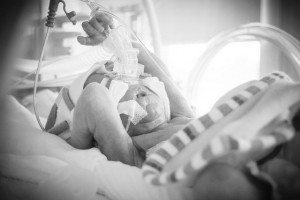What are the long-term effects of neonatal brain injury?
The long-term effects of neonatal brain injury vary by the type, nature, and extent of the baby’s brain damage. Initial birth injuries and neonatal brain injuries that can lead to long-term effects include fetal oxygen deprivation and hypoxic-ischemic encephalopathy (HIE), brain bleeds (intracranial hemorrhages), fetal strokes, neonatal sepsis (infection in the blood), jaundice and kernicterus (high bilirubin levels), and neonatal hypoglycemia. Throughout this page, we’ll discuss everything you need to know about the long-term outcomes for children with hypoxic-ischemic encephalopathy, periventricular leukomalacia (PVL), and other types of brain damage. While the conditions, injuries, and disabilities associated with infant brain damage vary greatly, common long-term effects of neonatal brain injury include epilepsy and seizure disorders, cerebral palsy (CP), motor disorders, intellectual/developmental disabilities, and more.
Neonatal Brain Injuries That Can Cause Long-Term Damage
Hypoxic-Ischemic Encephalopathy (HIE)
 Problems with the placenta, uterus and umbilical cord, as well as brain bleeds, strokes and sepsis can cause HIE. HIE often leads to the child having seizures and a later diagnosis of cerebral palsy. Some children with HIE do not receive a cerebral palsy diagnosis, but they may have lifelong learning problems, intellectual impairments, or motor disorders. If a baby has hypoxic-ischemic encephalopathy (HIE) and receives hypothermia treatment, it is possible to have no long-term problems. However, the child should be frequently examined and should have regular head imaging studies to assess the evolution of the initial brain injury. Usually, the severity of HIE cannot be determined until the child is 3 or 4 years old.
Problems with the placenta, uterus and umbilical cord, as well as brain bleeds, strokes and sepsis can cause HIE. HIE often leads to the child having seizures and a later diagnosis of cerebral palsy. Some children with HIE do not receive a cerebral palsy diagnosis, but they may have lifelong learning problems, intellectual impairments, or motor disorders. If a baby has hypoxic-ischemic encephalopathy (HIE) and receives hypothermia treatment, it is possible to have no long-term problems. However, the child should be frequently examined and should have regular head imaging studies to assess the evolution of the initial brain injury. Usually, the severity of HIE cannot be determined until the child is 3 or 4 years old.
Periventricular Leukomalacia (PVL)
Periventricular leukomalacia (PVL) is a type of brain injury caused by a decreased oxygen/blood flow to the periventricular region of the brain and damage to the cells that make up most of the white matter in the brain. Typically, there is inadequate blood circulation in the white matter of the brain next to the ventricles. Peri means near, ventricular refers to the ventricles or fluid spaces of the brain, and leukomalacia is softening of the white matter of the brain. The softening occurs because brain tissue in this area has died.
Since PVL results in the loss of vital areas of brain tissue, particularly motor fibers that control muscle movements, cerebral palsy (CP) usually develops in children who have PVL. Cerebral palsy caused by PVL is likely to be spastic and moderate to severe. Mild to severe intellectual disability may occur along with PVL, but some children with PVL and spastic cerebral palsy have normal intelligence. Although PVL can occur in term infants, it is more common in premature babies.
Hydrocephalus
Hydrocephalus occurs when bleeding inside the brain’s ventricles progresses into significant swelling of the ventricles. Hydrocephalus can lead to damaged blood vessels and destruction of the white matter portion of the brain. It can cause a child to have seizures, cerebral palsy, and intellectual/developmental disabilities. Sometimes children with hydrocephalus need to have a shunt placed in their head. Using tubes, a shunt system redirects the flow of fluid from an area of buildup in the brain to the abdominal cavity, where it can be absorbed into the child’s circulatory system.
Long-Term Disabilities Caused by Neonatal Brain Injury
In this section, we’ll explain some of the long-term consequences a child may face from neonatal brain injuries.
Cerebral Palsy
Cerebral palsy is caused by injury to the motor control centers of the brain. When a child has cerebral palsy, it affects his or her movement, posture, balance, and coordination. Cerebral palsy can be mild, moderate, or severe. It affects only one or two limbs in some children but causes other children to need a wheelchair.
Spastic cerebral palsy is by far the most common type, affecting 70 – 90% of all children who have CP. Children with spastic cerebral palsy struggle with movement because there is improper communication between the brain and muscles. Normally, muscles coordinate in pairs, which means that when one muscle group tightens, the other group relaxes. In spastic cerebral palsy, muscles that are supposed to coordinate in pairs actually become active at the same time, which blocks coordinated movement. Children with spastic cerebral palsy that primarily affects the lower body have a scissor gait. A scissor gait is characterized by the following:
- Knees and thighs cross or touch while walking
- Hips and pelvis are usually locked, as if crouching while walking
- Arms and hands go outwards from the body to provide balance
- Ankles are turned inwards while walking
- Tiptoe walking
Since cerebral palsy can affect so many different muscles, children with cerebral palsy may have problems with oral-facial muscles, making it difficult to eat or drink, and they may also have problems controlling their bladder and other bodily functions.
Seizure Disorders and Epilepsy
Hypoxic-ischemic encephalopathy (HIE) is the most common cause of seizures in a newborn, but many different types of neonatal brain injuries can cause seizures. Brain injury is associated with a decrease in energy production in the brain, which causes excessive excitation of brain impulses, leading to seizures. Seizures occur when there is uncontrolled electrical activity in the brain, causing altered consciousness and convulsions.
The underlying cause of the seizure activity must be treated, if possible, since seizures can worsen existing brain damage. Seizures can be treated with anti-epileptic medication, but this will usually not be effective in controlling seizure activity if the underlying cause of the seizures is not treated. Some underlying causes of seizures include neonatal hypoglycemia, meningitis, herpes encephalitis, metabolic problems and other conditions that cause brain disturbances. If hypoxic-ischemic encephalopathy is promptly treated with hypothermia treatment, the HIE may be minimized enough that seizures do not occur.
Approximately one-third of all children with cerebral palsy also have seizures and epilepsy.
Motor Disorders
Motor disorders are caused by damage to the motor system of the brain, often the basal ganglia. Cerebral palsy is a type of motor disorder, but children can have a motor disorder diagnosis without having a diagnosis of cerebral palsy. Motor disorders can range from the child having a lack of coordination and jerky movements (ataxia) to the child having uncontrollable, repetitive twisting movements of the affected body part (dystonia).
Intellectual and Developmental Disabilities (I/DD)
Intellectual and developmental disabilities occur when a child lacks mental processing skills as a result of brain dysfunction. Children diagnosed with intellectual and developmental disabilities may have low IQs, limited communication and social skills, and limited ability to care for themselves.
As children with intellectual and developmental disabilities (I/DD) develop, they may learn at a slower pace than peers. Some indications of intellectual and developmental disabilities include learning to walk or crawl later than most children, speech problems, difficulty remembering things, and difficulty with logic or problem-solving.
Children with intellectual and developmental disabilities typically begin experiencing limitations right after birth or shortly thereafter. However, the condition may not be noticeable until years later when certain developmental milestones are missed.
Trusted Neonatal Brain Injury Attorneys
If your loved one was diagnosed with a neonatal brain injury or experienced brain damage at birth as the result of medical malpractice, we urge you to contact Reiter & Walsh, P.C. Our Detroit, Michigan birth injury attorneys will provide you with a free case review and inform you of your legal options.
Free Case Review | Available 24/7 | No Fee Until We Win
Phone (toll-free): 888-419-2229
Press the Live Chat button on your browser
Complete Our Online Contact Form
Related Reading
- Birth Injury Video Library
- Birth Injury Glossary
- About Reiter & Walsh, P.C.
- Cases, Verdicts, and Settlements
Sources:
- Executive summary: Neonatal encephalopathy and neurologic outcome, second edition. Report of the American College of Obstetricians and Gynecologists’ Task Force on Neonatal Encephalopathy. Obstet Gynecol 2014; 123:896.
- Thornberg E, Thiringer K, Odeback A, Milsom I. Birth asphyxia: incidence, clinical course and outcome in a Swedish population. Acta Paediatr 1995; 84:927.
- Miller SP, Ramaswamy V, Michelson D, et al. Patterns of brain injury in term neonatal encephalopathy. J Pediatr 2005; 146:453.
- Okereafor A, Allsop J, Counsell SJ, et al. Patterns of brain injury in neonates exposed to perinatal sentinel events. Pediatrics 2008; 121:906.
- Executive summary: Neonatal encephalopathy and neurologic outcome, second edition. Report of the American College of Obstetricians and Gynecologists’ Task Force on Neonatal Encephalopathy. Obstet Gynecol 2014; 123:896.
- Redline RW. Severe fetal placental vascular lesions in term infants with neurologic impairment. Am J Obstet Gynecol 2005; 192:452.